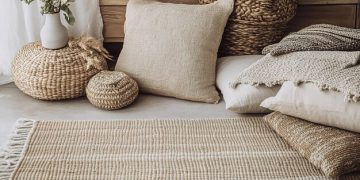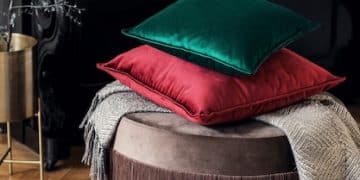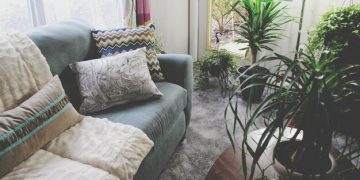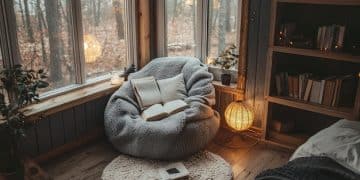The Impact of Texture: Elevating Your Home Decor
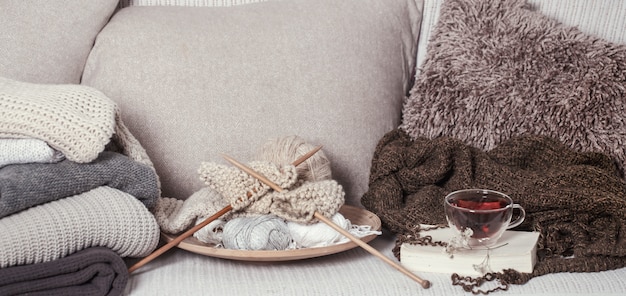
The impact of texture in home decor is significant, as it enhances visual interest, adds depth, and creates a more inviting and layered atmosphere in a space, enriching the overall aesthetic and tactile experience.
Looking to transform your living space from bland to grand? The secret lies in understanding and harnessing the impact of texture: adding depth and interest to your home decor. It’s not just about what you see, but what you feel.
Understanding Texture in Home Decor
Texture is a fundamental element of design, often overlooked. It’s the tactile quality of a surface, how it feels to the touch, and how it appears to feel. Incorporating different textures can dramatically change the ambiance of a room, making it more inviting and visually appealing.
Think of a minimalist room with stark white walls and sleek furniture. Adding a plush rug or linen curtains can instantly soften the space and introduce a layer of comfort and visual warmth.
Types of Texture
There are two main types of texture in design: visual and tactile. Visual texture is the illusion of texture created through patterns and finishes. Tactile texture is the actual physical feel of a surface.
Let’s explore these further:
- Visual Texture: Refers to the appearance of texture, such as the grain in wood or a printed pattern on fabric.
- Tactile Texture: The physical feel of a surface, like the roughness of burlap or the smoothness of silk.
- Combining Textures: The artful combination of both visual and tactile textures creates a balanced and interesting space.
By understanding the different types of texture, you can create a home that is both visually stunning and pleasing to the touch. This balance is key to achieving a well-designed and comfortable living environment.
Why Texture Matters
Texture plays a crucial role in interior design. It adds depth, visual interest, and a sense of luxury to a space. Without texture, a room can feel flat and uninviting. It also creates impact on how we perceive light within a room, influencing the mood and atmosphere.
Imagine a room designed with all smooth surfaces – the walls, furniture, and flooring. While it might appear clean and modern, it can also feel cold and sterile. Adding a variety of textures, such as a sheepskin rug or a woven wall hanging, introduces warmth and personality.
The Psychological Impact of Texture
Texture can evoke different emotions and sensory experiences. Rough textures can feel rustic and grounding, while smooth textures can feel sleek and sophisticated. The use of texture can be an art.
- Comfort and Warmth: Soft, plush textures like velvet or faux fur create a cozy and inviting atmosphere.
- Luxury and Sophistication: Smooth, shiny textures like silk or metal can add a touch of elegance and glamour.
- Nature and Grounding: Natural textures like wood, stone, or jute bring the outdoors in and create a sense of connection to nature.
By carefully selecting and combining textures, you can create a space that not only looks beautiful but also feels emotionally satisfying.
Incorporating Texture Through Fabrics
Fabrics are an easy and effective way to introduce texture into your home decor. From upholstery to curtains, the right fabrics can transform a room’s overall feel.
Consider a living room. Switching out your existing fabric sofa for one upholstered in chenille, corduroy, or tweed could revolutionize the comfort level and appearance.
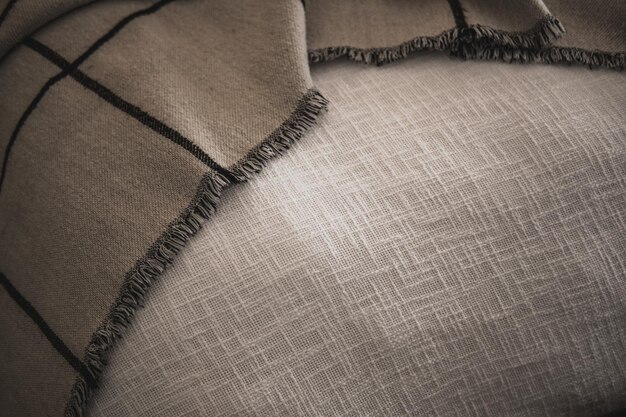
Choosing the Right Fabrics
When selecting fabrics, consider the overall style of your home and the function of the space.
Here’s how to choose for particular styles or functions:
- Velvet: Adds a touch of luxury and sophistication to any room.
- Linen: Offers a relaxed and casual feel, perfect for beach houses and bohemian-style homes.
- Wool: Provides warmth and texture, ideal for creating a cozy atmosphere in living rooms and bedrooms.
- Silk: Adds a sense of elegance and glamour, often used for decorative pillows and curtains.
Experiment with different fabric combinations to create a layered and interesting look. For example, pair a linen sofa with velvet pillows or a wool throw blanket.
By strategically using fabrics, you can easily introduce texture and enhance the visual appeal of your home.
Adding Texture with Accessories
Accessories are another fantastic way to add texture and personality to your home. From rugs to wall hangings, the right accessories can make a big impact.
Area rugs are wonderful for providing a layer of texture. Materials like jute, sisal, and wool provide different levels of tactile and visual interest. Textural elements draw the eye and add depth.
Texture in Details
Pay attention to the small details when incorporating texture through accessories.
Here are some ideas to consider:
- Rugs: Choose rugs with different pile heights and textures to add depth to your floors.
- Pillows: Mix and match pillows with different fabrics, patterns, and embellishments.
- Wall Hangings: Incorporate woven tapestries, macramé, or textured artwork to add visual interest to your walls.
By layering various textured accessories, you can create a space that is both visually appealing and inviting.
The Role of Natural Elements
Natural elements bring organic texture and depth to a space. Wood, stone, and plants introduce visual and tactile interest. They can create a sense of calm and serenity, connecting your home to the outdoors.
Consider the warmth of exposed wood beams in a farmhouse kitchen or fieldstone fireplace in a living room. Natural elements invite the outside in, increasing the relaxing and organic feel of your interior.
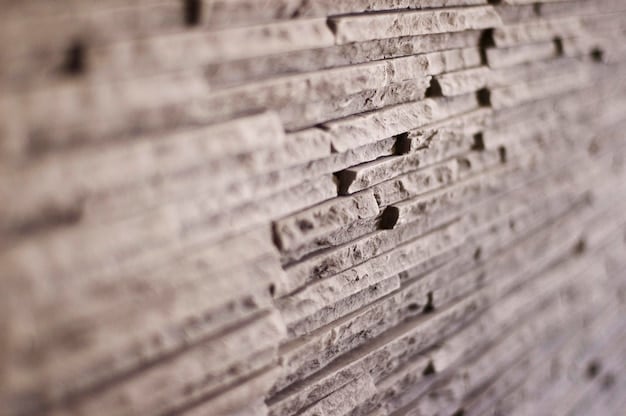
Bringing the Outdoors In
Incorporate natural elements through:
- Wood Furniture: Unfinished or reclaimed wood furniture adds rustic charm and tactile texture.
- Stone Accents: Stone fireplaces, countertops, or accent walls bring natural beauty and texture to your home.
- Plants and Greenery: Indoor plants add life, color, and texture while improving air quality.
By incorporating natural elements, you can create a home that feels connected to nature and evokes a sense of tranquility. The organic textures and colors add warmth and personality, making your space more inviting and comfortable.
Balancing Textures for a Cohesive Look
Creating a cohesive look with texture involves balancing different textures and patterns to achieve a harmonious and visually appealing space. A balanced approach ensures that no single texture overwhelms the rest.
Achieving the right balance can make all the difference. Too much of one texture can make a room feel monotonous, while too many competing textures can be visually chaotic.
Tips for Balancing Textures
Here are several considerations for texture balance:
- Mix Smooth and Rough: Combine smooth textures like silk or metal with rough textures like burlap or stone to create a dynamic contrast.
- Vary Scale: Use textures with different scales. For example, pair a large-scale woven rug with small-scale textured pillows.
- Consider Color: Choose textures in complementary colors to create a cohesive look. Neutral colors allow textures to stand out without being overwhelming.
By carefully balancing textures and colors, you can create a space that is both visually interesting and harmonious. Don’t be afraid to experiment and trust your instincts until you find the right balance for your home.
| Key Aspect | Brief Description |
|---|---|
| ✨Importance of Texture | Adds depth and interest to rooms. |
| 🛋️Fabrics | Use velvet, linen, wool to bring new feelings. |
| 🌿Natural Elements | Wood, stone and plants evoke peace. |
| ⚖️Balance | Harmonize rough and soft textures for style. |
Frequently Asked Questions (FAQ)
▼
Texture adds depth, visual interest, and a tactile quality to a space. It prevents a room from feeling flat and can transform the overall ambiance, making it more inviting and stimulating.
▼
Fabrics are a primary means of introducing texture. Different fabrics like velvet, linen, and wool offer unique textures. Upholstery, curtains, and throw pillows can significantly influence texture.
▼
Rugs with high or low piled materials, woven wall hangings, and decorative pillows with textured covers are excellent choices. Details like baskets and woven lighting add to the effect.
▼
Natural elements such as wood, stone, and plants introduce organic textures that connect the interior with the outdoors. Each material adds depth and creates a calming, serene environment.
▼
Balancing visual textures involves mixing smooth and rough elements, varying scale, and considering color palettes. Ensure no single texture overwhelms the rest of the space’s design.
Conclusion
Incorporating texture into your home decor is a powerful way to elevate your living space, adding depth, interest, and a unique personality. By understanding the different types of textures and how to balance them, you can create a home that is both visually stunning and emotionally satisfying. Experiment with fabrics, accessories, and natural elements to transform your space into a cozy and inviting haven.
